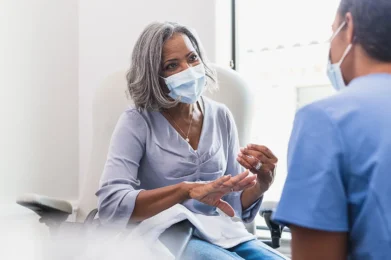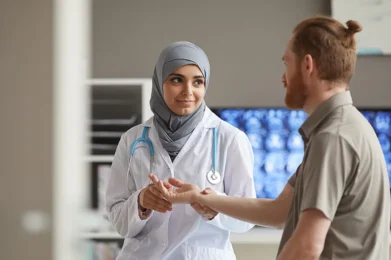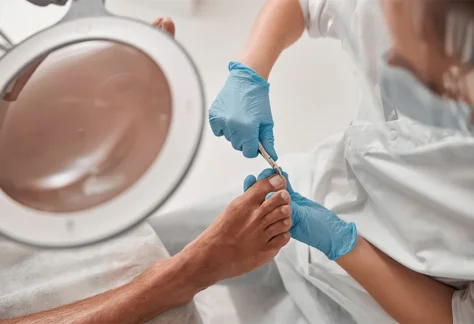In This Article:
- Cancer is caused by an uncontrolled growth of cells in the body. The most commonly affected organs are the breast, lung, colon, prostate and skin. Everyone can get cancer, but risk increases with obesity, smoking and age.
- Treatment methods become more effective every year and include surgery, chemotherapy, radiation and immunotherapy.
- You should be screened for certain types of cancer every one to three years, but visit your doctor immediately if you have unexplained, persistent weight loss or pain — or if you find a lump.
How Does Cancer Work?
First, it’s important to understand what cancer is and how it spreads. Cells are the building blocks of our bodies, and in a healthy body, these cells eventually get old and die out. However, in a body with cancer, the cells in a certain organ divide and refuse to die. Then, they move on to other parts of the body and eventually take it over.
Most cancers have four stages. The higher the number, the more advanced it is.
- Stage One: The cancer is limited to the organ of origin.
- Stages Two and Three: The cancer has spread to local areas.
- Stage Four: The cancer has spread to other organs of the body like the liver or brain
What Are the Most Common Types of Cancer?
There are more than 120 cancers on record, but each organ can carry many subtypes of cancer. Although this disease has been around for thousands of years, it’s much more prevalent today. Now that the life expectancy is about 80 (rather than 40, as it was just 100 years ago), we have an increased chance of developing cancer.
The most affected organs include:
- Breast: 1 in 8 U.S. women (about 13%) will develop invasive breast cancer over the course of their lifetime.
- Lung: The chance of developing lung cancer in your lifetime is 1 in 15 for men and 1 in 17 for women. This includes both smokers and nonsmokers.
- Colon: The lifetime risk of developing colorectal cancer is about 1 in 23 (4.3%) for men and 1 in 25 (4.0%) for women.
- Prostate: About 1 in 8 men will be diagnosed with prostate cancer during their lifetime.
- Skin: 1 in 5 Americans will develop skin cancer by age 70.
What Causes Cancer?
Everyone — regardless of ethnicity, gender or age — is susceptible to cancer. However, the older you are, the more likely it is. About 90% of cancers occur in people over 50 years of age.
Contributing factors can either be genetic or lifestyle based. Smoking is the number one controllable cause of cancer, but obesity is quickly catching up. In fact, 80% of cancer diagnosed today are related to diet, lack of exercise or increased body weight. Excessive alcohol consumption is a leading risk factor, as well.
Chronic stress can also lead to cancer, unlike acute stress caused by everyday inconveniences. This refers to long-term stress from major life changes, like divorce, death or losing work. With enough tension, your body’s response mechanisms will weaken, making you more prone to certain types of cancer.
Finally, 3 to 10% of cancers are genetic. In this case, you’ve inherited genes from your family that predispose you to cancer, and it is important to be vigilant about catching them early. It is also another reason to decrease your lifestyle-based risk factors for cancer. In other instances, your genes influence how you react to environmental factors such as sunlight, viruses and lifestyle choices. These may cause mutations in your genes, spurring the growth of cancer.
Is Cancer Contagious?
Cancer itself is not contagious. The only way to “catch “cancer is via an organ transplant or blood donation from someone who currently has or recently had the disease. However, many viruses transmitted from person to person — like Hepatitis B and C, HIV and HPV — may lead to cancer. Out of these conditions, HPV and Hepatitis B have vaccines available.
How Is Cancer Treated?
Although cancer diagnosis is on the rise, there is some good news. Survival rates have improved by more than 30% since the 1970s and continue to improve by about 2% every year. Plus, scientists and doctors from around the world have recently made major breakthroughs in treatment methods. Here are a few of the most common:
- Surgery: If diagnosed early enough, the surgeon may be able to simply remove the affected area and rid the body of cancer.
- Chemotherapy: These pills or infusions kill off cancer cells. This can either reduce the size of the affected area, allowing it to be cut out more easily, or control the disease for as long as possible.
- Radiation: Here, invisible radiation beams enter your body to kill off cells.
- Immunotherapy: Immunotherapy puts the concept of a cure almost within our reach. This method trains your immune system to recognize cancer cells and kill them off, essentially teaching it to outsmart the cancer cells. Because other treatments can cause severe side effects, using our own body as a defense system is an incredible breakthrough.
- Targeted treatments and precision medicine: Experts have recently found many new targets for cancer treatment, and their specific drugs can be used in these situations.
The goal of all treatment techniques is, of course, to help you reach remission. In partial remission, some, but not all, signs and symptoms of cancer have disappeared. In complete remission, all signs and symptoms of cancer have disappeared. Although there is no guarantee it will never come back, the longer you are cancer-free, the less of a chance it has of returning.
What Are the Warning Signs of Cancer?
You should visit your doctor if you experience any of the following symptoms.
- Unexplained weight loss
- Unexplained, persistent pain
- Lumps and bumps
- Coughing up blood and persistent chest pain
Oncologists also recommend that adult women be screened for cervical cancer with a Pap smear every one to three years, as well as breast cancer with a mammogram every one to two years starting at age 40. Everyone over age 45 should have screening colonoscopies for colon cancer.
If you experience any long-term pain that appeared out of nowhere, visit your doctor right away. And, if cancer runs in your family, you may want to consider genetic counseling. Regardless, the sooner you detect any type of cancer, the better your chances of beating it.
Sources:
- https://www.healthline.com/health/lung-cancer/lung-cancer-age
- https://www.cancer.org/content/dam/cancer-org/research/cancer-facts-and-statistics/breast-cancer-facts-and-figures/breast-cancer-facts-and-figures-2019-2020.pdf
- https://www.cancer.org/cancer/colon-rectal-cancer/about/key-statistics.html
- https://www.skincancer.org/skin-cancer-information/skin-cancer-facts/
- https://www.cdc.gov/hpv/parents/vaccine.html
- https://acsjournals.onlinelibrary.wiley.com/doi/full/10.3322/caac.21660








